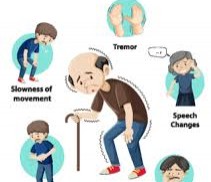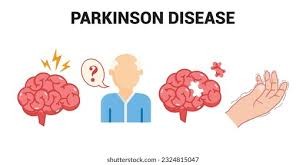Understanding Parkinson’s Disease: A Comprehensive Guide


What is Parkinson’s Disease?
Have you ever wondered what causes the tremors and stiffness some older adults experience?
Parkinson’s disease is a chronic and progressive neurological disorder that affects movement. It occurs when the brain's dopamine-producing neurons in a specific area called the substantia nigra become impaired or die. Dopamine is a chemical messenger that plays a crucial role in coordinating smooth and balanced muscle movements. As dopamine levels decrease, patients gradually lose the ability to control their body’s movements effectively.
Key points:
- Parkinson’s disease affects the central nervous system.
- Caused by the loss of dopamine-producing brain cells.
- Typically develops after the age of 60, but early-onset cases can occur.
- The exact cause is unknown, but genetics and environmental factors play a role.
Symptoms of Parkinson’s Disease
What are the warning signs and symptoms of Parkinson’s disease?
Parkinson’s disease develops gradually, and early symptoms may be subtle. The progression and severity of symptoms can vary from one individual to another. Common early signs include slight tremors, difficulty with balance, and changes in handwriting.
Common symptoms include:
-Motor Symptoms:
- Tremors, usually starting in the hands or fingers.
- Slowed movement (bradykinesia).
- Muscle stiffness and rigidity.
- Impaired posture and balance.
-Non-Motor Symptoms:
- Sleep disturbances.
- Depression or anxiety.
- Constipation and urinary problems.
- Cognitive changes and memory loss in later stages.
Causes and Risk Factors
Why does Parkinson’s disease happen, and who is at risk?
While the exact cause of Parkinson’s disease remains unclear, several risk factors have been identified. It is believed to be a combination of genetic mutations and environmental triggers. Although not always inherited, those with a family history may have an increased risk.
Possible causes and risk factors:
- Age: Most common in people over 60.
- Genetics: Mutations in specific genes such as LRRK2 and PARK7.
- Exposure to toxins: Prolonged contact with herbicides and pesticides.
- Gender: Men are slightly more likely to develop the condition than women.
- Head trauma: Previous head injuries may contribute to risk.
Diagnosing Parkinson’s Disease
How is Parkinson’s disease diagnosed?
There is no specific test to conclusively diagnose Parkinson’s disease. Instead, doctors rely on a combination of medical history, physical exams, and observation of symptoms. Neurologists are often consulted to rule out other similar disorders.
Diagnosis methods include:
- Review of medical and family history.
- Neurological and physical examination.
- Monitoring symptoms over time.
- Imaging tests (MRI, PET scans) to rule out other conditions.
- Positive response to Parkinson’s medications may support diagnosis.
Treatment Options for Parkinson’s Disease
Can Parkinson’s disease be treated or managed?
Although there is currently no cure for Parkinson’s disease, a variety of treatments can help manage symptoms and improve quality of life. Treatment plans are often personalized, combining medication, therapy, and lifestyle changes.
Treatment options include:
-Medications:
- Levodopa/Carbidopa to boost dopamine levels.
- Dopamine agonists like Mirapex (Generic name: Pramipexole) to mimic dopamine’s effects in the brain.
- MAO-B inhibitors and anticholinergics to manage symptoms.
-Therapies:
- Physical therapy to improve mobility and balance.
- Occupational therapy for daily task assistance.
- Speech therapy to address speech and swallowing issues.
- Surgical interventions: Deep brain stimulation (DBS) for advanced cases.
Living with Parkinson’s Disease
How can individuals cope with Parkinson’s disease on a daily basis?
Living with Parkinson’s disease presents daily challenges, but with the right support, many people lead fulfilling lives. Establishing a strong care team and engaging in community support can make a significant difference. Staying active and mentally engaged is also crucial for managing long-term health.
Helpful strategies for managing daily life:
- Maintain a regular exercise routine.
- Eat a healthy, balanced diet rich in fiber.
- Join support groups for social connection and emotional support.
- Keep a symptom diary to track changes and treatment responses.
- Use medications like Pramipexole (Mirapex) as prescribed to control motor symptoms effectively.
Mirapex (Pramipexole): A Key Medication in Parkinson’s Management
What role does Mirapex (Pramipexole) play in treating Parkinson’s disease?
Mirapex, with the generic name Pramipexole, is a dopamine agonist commonly prescribed to treat the symptoms of Parkinson’s disease. It works by stimulating dopamine receptors in the brain, essentially mimicking the effects of dopamine — the neurotransmitter that Parkinson’s patients gradually lose. By acting on these receptors, Mirapex helps improve motor functions and reduce symptoms such as tremors, stiffness, and slowed movement.
Key facts about Mirapex (Pramipexole):
- Approved for use in early and advanced stages of Parkinson’s disease.
- Can be used alone or in combination with Levodopa.
- Often beneficial for reducing "off" episodes when other medications wear off.
- May also be prescribed to treat Restless Legs Syndrome (RLS).
- Common side effects include dizziness, drowsiness, nausea, and hallucinations, especially in elderly patients.
Mirapex is an essential tool in the Parkinson’s treatment arsenal, providing relief for many patients and helping to restore independence in daily life. As with any medication, it should be taken under the supervision of a healthcare provider, with dosages carefully adjusted based on individual response and tolerance.
Article Post: Editorial Team of RXShop.md
(Updated at Apr 11 / 2025)